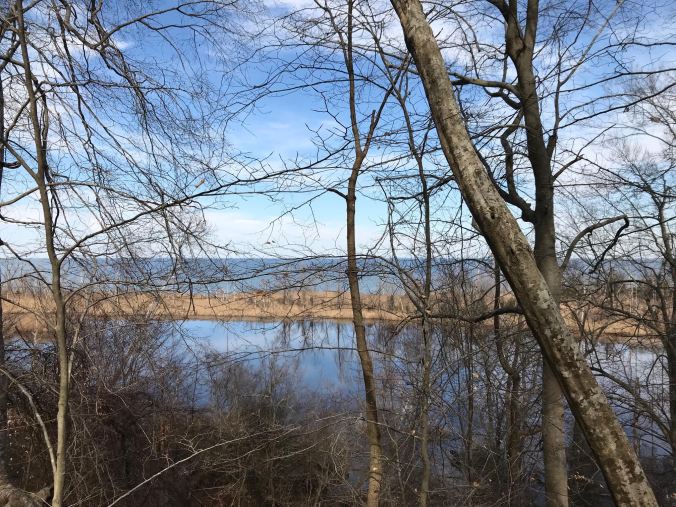I hadn’t set foot on the trails at Flag Ponds Nature Park in over four months. I have honestly missed the North Ridge Trail and South Ridge Trail, thinking about them often and wanting to check in with them, like old friends whose voices I long to hear.
My absence is partly due to my discovery of the American Chestnut Land Trust Trails, (make new friends, but keep the old . . .) but more due to the limited hours Flag Ponds is open during the winter. (Only Friday through Monday 9am to 4pm – entry gate closes at 3pm. Not that I’m bitter. Or that I’m a forgetful lazybones who couldn’t remember to get her hind end to the park before 3pm.)
But Sunday, I made it; daylight savings time has pushed the park’s closing till 5pm (entry gate closes at 4pm) and I was there at 2:43! Ha!
And my old trail “friends” were so happy to see me that they provided one wonderful encounter after another, including:

This is the ridge-bottom entry to the Northridge Trail. I left my house under dull, gray cloud cover; fifteen minutes later the trailhead greeted me with azure sky, fluffy white clouds, and warm sunshine. It was like a “Welcome Back!” sign from the universe.

Ripening buds on a cut-leaved toothwort (Dentaria laciniata), one of the earliest spring bloomers on the forest floor. Once I noticed this one, my eyes “woke” to them and they were popping up through the leaf litter everywhere!

And speaking of teeth . . . if you look closely at the beige bit of detritus at the top of the screen, you’ll notice that it’s a set of two molars that have worked their way free of this carnivore’s scat. I guess that the scat was made by a fox, since it was left in the middle of a bridge, and that’s always where I seem to find fox scats. Whatever this fox ate, it had gray fur and teeth made for grinding up seeds and plant matter.

Just a quarter mile further up the trail, I found more evidence of a successful predator. This lunch had white fur, though, spread out in clumps over a four foot square area.

The stalks growing up from this bed of moss are sporangia – stems with a pouch at the end that holds the developing moss spores. A new generation of moss in the making!

These are the dried seedpods of the invasive Royal Paulowina tree (Paulownia tomentosa). I was sad to find them already empty, their seeds having fallen somewhere in the forest, ready to take nutrients from native species that are pillars of the ecosystem. I also noticed how much the seed pods look like the head of the alien plant from Little Shop of Horrors; how apropos.

I heard a rustling in the leaves just next to my right foot. Usually rustling in the forest is a squirrel or bird, but this was close and small and so I looked down and was delighted to see a spotted salamander (Ambystoma maculatum) making its way to the swamp.
Check out this happy little video of the spotted salamander (we’ll call him Sal) making his way through the leaf litter:

The pond and the Bay beyond. What you can’t see in this picture, but what absolutely MADE my hike, was the pair of green-winged teal ducks (Anas carolinensis) revealed by my binoculars. My first green-winged teals EVER! And the female was having a quick bath-and-preen, so she was showing off her teal wing patch over and over. Gorgeous!

On the South Ridge trail, I found this moss with tiny, red and yellow bell-shaped sporangia. The world of tiny things is fascinating!
Another stroke of luck – the leaf shown in the pictures above was flipped over so that I saw its amethyst underside. Had I seen only the green top, I might never have noticed it, but that deep purple drew my eye and my camera like a magnet. Research reveals that it is the foliage of a cranefly orchid (Tipularia discolor), which means I can look forward to finding a beautiful 15-inch stalk of blossoms when the weather warms. Check out this wonderful blog post by Mary Anne Borge, complete with excellent pictures, about the cranefly orchid.

A bouquet upon leaving. This vine has just sent out a shock of new leaves to gather energy from the late winter sun. I haven’t identified the vine properly yet, but knowing that it winds around the tree clockwise (ascending from right to left) is a big clue – the way a vine winds is coded in its DNA; clockwise vines will never wind counter-clockwise, and so you can use winding direction to help identify species.
For more shots from the trails at Flag Ponds, read:
Trail Photos: Flag Ponds Nature Park North and South Ridge Trails
Mushroom Mysteries & Fungus Fails

